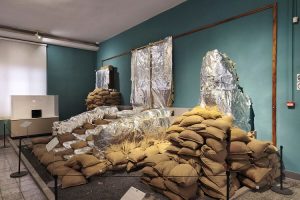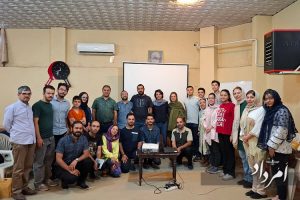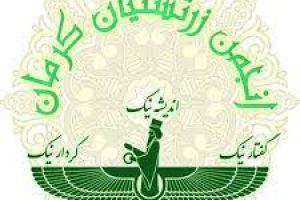The sanctuary and the site of the country’s only Sassanid fire temple in Darab city, have been seriously damaged. A large part of it has been destroyed in an immature and unexpert plan by the Department of Cultural Heritage, Tourism, and Handicrafts to develop tourism infrastructure. For this reason, cultural heritage experts and activists have called for a complete stop to the plan and its dismantling.
According to Amordad, reporters and researchers know the Azarakhsh fire temple in Darab city to be the most unique fire temple of the Sassanid period, which is carved into the mountainside, in a consolidated manner, and is of special value among experts and archeologists. This Sassanid fire temple, which was changed to a mosque in the Islamic period and is also known as the Stone Mosque, is considered one of the country’s most valuable historical and cultural monuments. Azarakhsh Fire Temple is going through hard days, and the Department of Cultural Heritage, Tourism and Handicrafts of the province recently, in the name of developing tourism infrastructure in an immature and unexpert plan, has been trying to level the ancient bed in front of the Sassanid structure with heavy machinery. Furthermore, a large part of the arena of the Sassanid relic has been seriously damaged, which damage is irreversible, and this is moving the heart of every lover of Iranian history and culture.
The surprising and unbelievable point in this story is that, in response to the protests who demanded to stop the implementation of the mentioned project and to prevent further damage to the sanctum of the Sassanid monument, the unexpected point and attitude of the story are that the cultural heritage officials dismissed the warnings as baseless and just a hue and cry from the archeologists and news agencies, and fully dismiss their claims. Worst of all, they even deny the existence of the ancient bed of this site! They considered the actions taken not as the destruction but as the implementation of a tourism plan to develop infrastructure within the structure’s limitations.
It is well known that the presence of heavy machinery near historical works and monuments for any reason and motive is incorrect and prohibited based on cultural heritage laws. Also, performing any work next to historical and artistic works and monuments requires a work permit from the country’s archeology research institutes, cultural heritage, and tourism. On the other hand, when any plan is conducted next to historical and cultural buildings and monuments, the presence of an archeology expert is required. In the implementation of the tourism infrastructure development plan in Azarakhsh Darab fire temple, no archeologist was present, which is why the damage occurred in the sanctuary of the Sassanid relic.
The plan to build a stone pavement in front of the Azarakhsh fire temple will be implemented and it is no problem!
However, to follow up and learn more about the tourism project implementation next to the valuable fire temple of Azarakhsh Darab, the author went to the General Directorate of Cultural Heritage, Tourism and Handicrafts of the province and talked with the relevant expert. In the shocking statement of the cultural heritage expert, he denied any destruction and damage to the arena and sanctuary of the Sassanid monument and also denied the existence of the ancient bed and cultural deposits and considered them baseless. Also, in defense of the action taken, he said the project was implemented within the Sassanid structure’s boundaries and denied its being progressed towards the building arena. This expert-in-charge believes that erecting a small stone staircase, 120 m long, for tourists, will not be a problem.
In response to the small piles of pottery in the agricultural lands in front of the fire temple, this cultural heritage official considered them baseless and said that we had not seen any pottery nearby!
In response to the question that even if the actions taken are within the boundaries of the building, won’t it undoubtedly damage and destroy the relics hidden in the heart of the earth, and isn’t there a need for archeological study, the cultural heritage expert denied the existence of any archeological relics in the boundaries of the fire temple and said that there is no need for any archeological excavation because there is nothing under the ground.
The cultural heritage official also commented about the lack of a work permit from the research institutes of archeology and cultural heritage and tourism of the country: “The plan has been approved by the provincial cultural heritage department and will be implemented, there is no problem about it!
An archaeologist: The ancient site of Azarakhsh fire temple has been destroyed
However, Alireza Jafarizand, an archeologist with orientation in historic periods, who has visited this Sassanid building many times, told the author: “The ancient site of Azarakhsh fire temple has been seriously damaged and destroyed by heavy machinery. Also, the mentioned plan is being implemented in the Yadegar Sasanian Square, which will destroy the area’s archaeological layers and leave irreversible damage. This project should be stopped as soon as possible.”
Dr Jafarizand continued: “There is a lot of broken pottery scattered all over the front of the Azarakhsh fire temple and the surrounding agricultural land, and it is unclear why and how the cultural heritage authorities have been taking such irresponsible actions. Where in the world are heavy machinery used in the area and sanctuary of archeological structures? It should be known that no archeological speculation and exploration has been carried out in this place, and the entire area of the fire temple is full of valuable historical and cultural relics; but with the work that is going on, we have damaged its archaeological layers and tarnished the face of the site. This plan should be stopped as soon as possible. An impartial expert group should work here with all sensitivity and obsession after reviewing and having an approved program from the Research Institute of Archeology and Cultural Heritage and Tourism of the country.
In another part of his speech, this university professor added: “Azaraksh fire temple is one of the most precious and unique Sassanid ruins that is unparalleled to any other in the country so far, and It is a real pity that in an immature, unexpefrtised and in proficient plan, such damage is brought on to its ancient bed and sanctum.”
An expert of cultural heritage department: “Any project that is approved does not mean that it is correct”.
A retired expert of Fars provincial cultural heritage, tourism and handicrafts department gave his comments to Amordad about implementation of the plan in the Azarakhsh fire temple area, which is said to have been approved by the cultural heritage department of the province: “First, let me point out that any plan that is approved by a provincial cultural heritage does not mean that it is correct. It is unbelievable that when cultural heritage experts and activists find faults in a plan that is being implemented the authorities’ answer is that it has been approved by the provincial cultural heritage authorities. But when you go to the cultural heritage office, you will see that no rules and regulations are followed, and it is only the personal opinion of an expert.”
After him, Siamak Basiri added: “We should take a broader look at this matter. I mean that, when we say that a project has been approved by the cultural heritage officials, we should also declare the base upon which the experts’ approval has been given plus the legal steps that have been taken. When we visit sites where projects have been implemented, we see that none of the above has been considered and nothing is on a proper basis. Some officials in the provincial cultural heritage departments draw boundaries without observing the rules and regulations and/or using an expert’s opinion. Such a system of working will easily cause disasters like the one in the Azarakhsh Fire Temple.
In another part of his speech, this cultural heritage expert said: “Any tourism project within the scope of historical and cultural monuments/ruins/relics, apart from preventing unprofessional and unlawful interventions, the first step should be to protect these sites, and then only think about facilitating tourism. In other words, if the goal of protecting archeological sites is not adhered to, no other plan or idea can be implemented; it doesn’t make any difference whether the plan is for paving or bricklaying or installing sheds, planting trees or anything else. The most critical issue in implementing tourism projects is the protection part of these projects.
About Azarakhsh fire temple
The Azarakhsh fire temple in Darab is one of the most valuable structures of Sassanid period, which has remained more or less intact. Professor Hoff, a German archeologist, believes that this place has been a mosque right from the beginning. Some archeologists consider this place to have been a Mithra’s temple, transformed into a fire temple during the Sassanid period. Later, like most fire temples, its use changed according to times and conditions. Some researchers have considered this monument a Christian church based on its cross-shaped design. Mohammad Taqi Mostafavi, an archeologist, has identified it as a Sassanid fire temple. Finally, Dr Yusuf Kiyani associates this structure to a mosque in the 11th century (lunar calendar) but Alireza Jafarizand, an archeologist with focus on historical periods, said:
“In my opinion, this monument is related to the early Sassanid era and is not older in any way, and it has no connection with the pre-Sassanid period, and the date between 260 and 266 AD can be considered for it. Its use can be regarded as more or less the same as the Anahita temple of Bishapur, Kazeroon, because both ceilings are open, and the structure is the same, but with different forms. In Bishapur water is guided from the river to the temple, and some places it was done by guiding rainwater from the roof tops. Under the ceiling there is a shallow pond like structure. This could have been a place for prayer (place of worship) or a place for fire, which means water and fire together.
According to Amordad, this Sassanid monument was built 7 kilometers from Darab city and east of Panah Mountain. One of the characteristics of this structure is that all the walls, columns, ceilings, and rooms are carved out of the mountain. In 652 AD, this fire temple was transformed into a mosque and became known as the Stone Mosque. This fire temple was registered in the list of national monuments with number 229 on December 7, 1935.
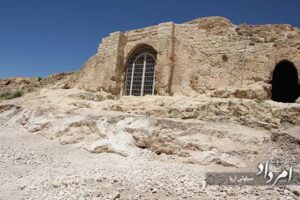
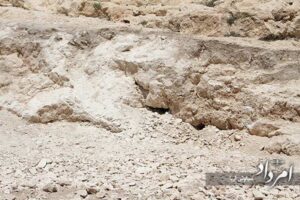
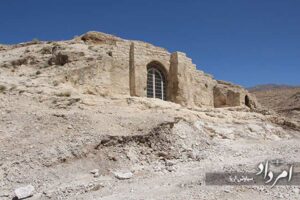
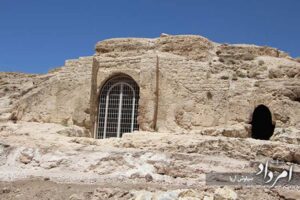



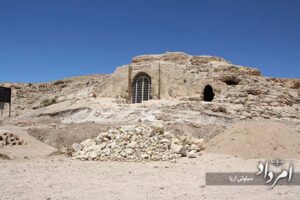

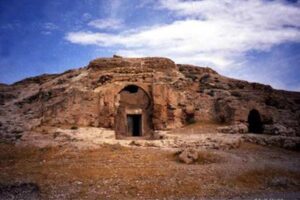
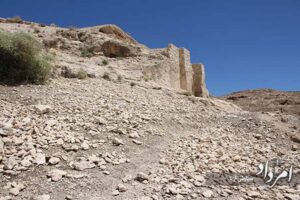
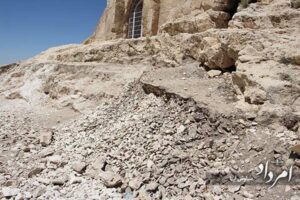

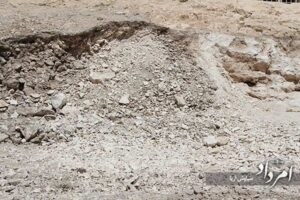

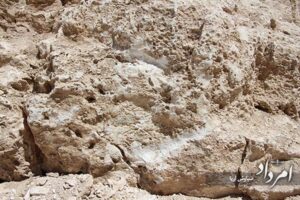

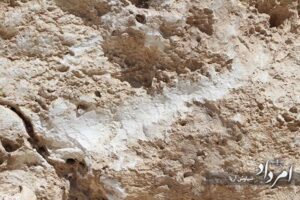
Photos by Siavosh Aria






